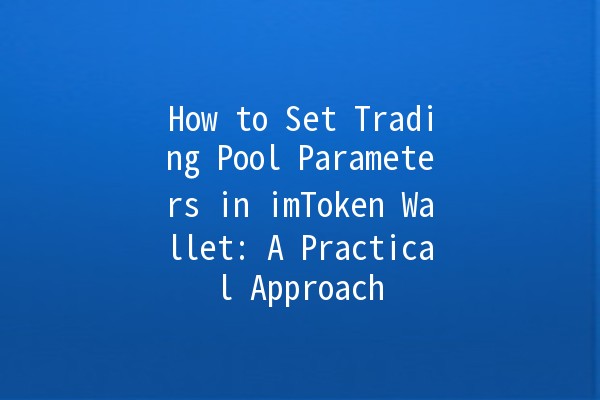Setting the right trading pool parameters in imToken wallet is crucial for achieving optimal performance in your cryptocurrency trading activities. Understanding how to adjust these settings can significantly elevate your trading strategy, whether you're a novice or a seasoned trader. Below, we delve into specific techniques to enhance productivity, ensuring you make the most of your experience.
Trading pools are essential components within the cryptocurrency realm. They allow users to merge their resources for better liquidity and pricing on trades. When utilizing imToken wallet, understanding how to adjust your trading pool parameters effectively can enhance your trading outcomes and user experience.

What is Slippage Tolerance?
Slippage tolerance determines how much price fluctuation you're willing to accept when executing a trade. In volatile markets, prices can change rapidly, and setting an appropriate slippage tolerance helps prevent unexpected losses.
How to Set It in imToken:
Example:
If you're trading a highly volatile token, you might want to set your slippage tolerance to 1% to ensure your trade goes through, even with minor price changes. Conversely, for less volatile assets, a lower setting is advisable to avoid unexpected losses.
Understanding Gas Fees:
Gas fees are transaction costs paid to miners for processing operations on the blockchain. High gas fees can eat into your profits, especially for frequent traders.
Steps to Track and Optimize:
Example:
If during peak hours gas fees spike to $10, but during offhours they drop to $2, scheduling your trade for a more optimal time can preserve your profits.
What are Limit Orders?
Limit orders allow you to set a specific price at which you want to buy or sell an asset. This feature helps you manage risk by letting you enter trades at your preferred price rather than the market price, reducing the chances of slippage.
Setting Limit Orders in imToken:
Example:
If you're aiming to buy a token but only want to purchase it at a lower price, set a limit order. If the token dips to your desired price, the order will execute automatically, thus providing better entry.
The Importance of Trading Volume:
Trading volume indicates how actively an asset is being traded. High trading volumes usually suggest better liquidity and less price volatility, making it easier to enter and exit trades.
Strategies to Analyze Volume:
Example:
If you observe a significant rise in trading volume for a cryptocurrency you're monitoring, consider reevaluating your position as such a movement may indicate upcoming price volatility.
Why Update Matters:
The cryptocurrency market is incredibly dynamic. Regularly reviewing your portfolio allows you to adapt to market changes and ultimately enhance your trading strategy.
How to Keep Your Portfolio Current:
Example:
If you notice one of your held assets consistently underperforming, consider reallocating those funds into a more promising opportunity or a developing sector within cryptocurrency.
Slippage tolerance refers to the variation in price you are willing to accept for a transaction. It is crucial in volatile markets where prices can change significantly between the initiation of a trade and its execution. Setting a proper slippage tolerance ensures that your trades execute even with minimal price fluctuations, reducing the risk of significant losses due to sudden market shifts.
To minimize gas fees, consider conducting trades during nonpeak hours when fewer transactions are happening on the blockchain. Additionally, you can adjust your gas fee settings in imToken by setting a maximum fee you are comfortable paying. Checking gas fee trends through various analytical tools can also help you choose optimal times for your trades.
Limit orders provide more control over the price at which you buy or sell an asset. Unlike market orders, which execute immediately at the current market price, limit orders trigger only when your specified price is reached. This feature reduces the risk of slippage, allowing you to strategize your entries and exits more effectively.
Trading volume indicates the liquidity of an asset and reflects whether it is actively traded. High trading volumes usually correlate with tighter bidask spreads and lower risks of slippage. By analyzing trading volume, traders can make more informed decisions about when to execute trades or when to hold their positions.
It's advisable to review your cryptocurrency portfolio regularly—at least once a month. However, you should also consider market conditions, news, and your personal financial goals. Frequent evaluations allow you to adapt to market dynamics, seize new opportunities, and avoid potential losses.
Yes, many traders utilize thirdparty tools that provide advanced market analysis, charting features, and price alerts. Integrating these tools with your imToken wallet can help streamline your trading strategy, providing enhanced data analytics that may be beneficial in making more informed trading decisions.
Understanding how to maneuver and optimize your experience with imToken wallet can drastically affect your trading efficiency. By implementing these five practical productivity techniques, you can ensure that you not only enhance your trading strategies but also enjoy a smoother trading journey within the everevolving world of cryptocurrencies.